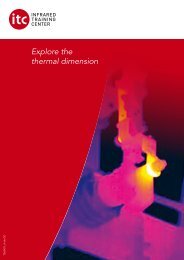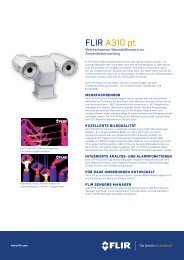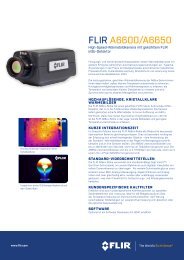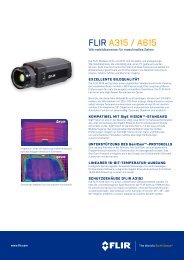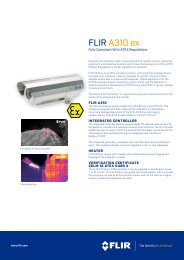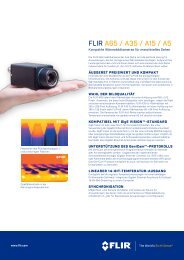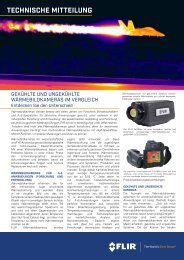Booklet Forschung und Entwicklung EN
You also want an ePaper? Increase the reach of your titles
YUMPU automatically turns print PDFs into web optimized ePapers that Google loves.
IR Thermography – How It Works<br />
science of thermography, because it is the<br />
fo<strong>und</strong>ation for relating IR radiation to an<br />
object’s temperature.<br />
F<strong>und</strong>amentally, a perfect blackbody is a<br />
perfect absorber and emitter of radiant<br />
energy. This concept is stated mathematical<br />
as Kirchhoff’s Law. The radiative properties<br />
of a body are denoted by the symbol e,<br />
the emittance or emissivity of the body.<br />
Kirchhoff’s law states that a = e, and<br />
since both values vary with the radiation<br />
wavelength, the formula can take the<br />
form a(l) = e(l), where l denotes the<br />
wavelength.<br />
The total radiation law can thus take the<br />
mathematical form 1 = e + r + t, which for<br />
an opaque body (t = 0) can be simplified<br />
to 1 = e + r or r = 1 – e (i.e., reflection =<br />
1 – emissivity). Since a perfect blackbody is<br />
a perfect absorber, r = 0 and e = 1.<br />
The radiative properties of a perfect<br />
blackbody can also be described<br />
mathematically by Planck’s Law. Since this<br />
has a complex mathematical formula, and<br />
is a function of temperature and radiation<br />
wavelength, a blackbody’s radiative<br />
properties are usually shown as a series<br />
of curves (Figure 3).<br />
These curves show the radiation per<br />
wavelength unit and area unit, called<br />
the spectral radiant emittance of the<br />
blackbody. The higher the temperature,<br />
the more intense the emitted radiation.<br />
However, each emittance curve has a<br />
distinct maximum value at a certain<br />
4.50<br />
4.00<br />
T-1000˚C<br />
Blackbody spectral radiant emittance<br />
3.50<br />
3.00<br />
2.50<br />
2.00<br />
1.50<br />
1.00<br />
0.50<br />
T-900˚C<br />
T-800˚C<br />
T-700˚C<br />
T-600˚C<br />
T-500˚C<br />
T-400˚C<br />
T-300˚C<br />
T-200˚C<br />
0.00<br />
Visible<br />
light<br />
2 3 4 5 6 7 8 9 10 11 12 13 14 15<br />
Figure 3. Illustration of Planck’s Law<br />
3





